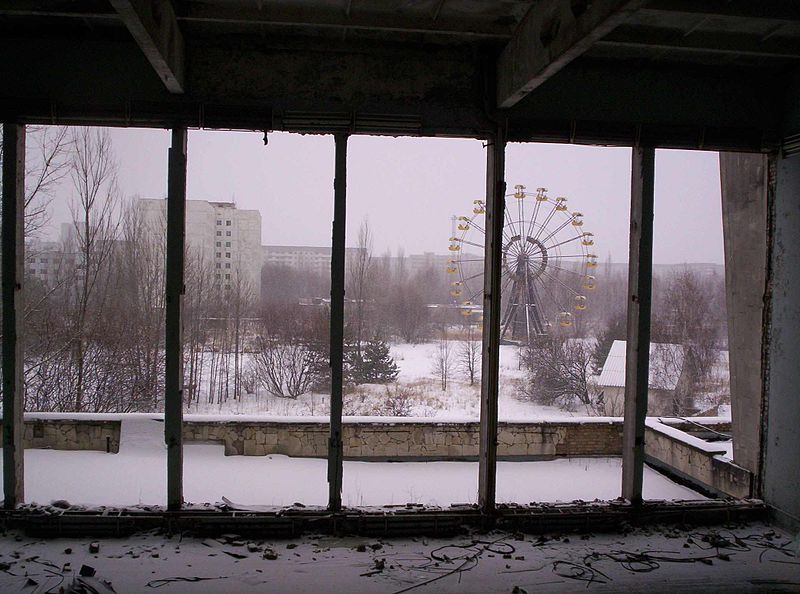 |
| The never-used Pripyat Amusement Park ferris wheel. |
This government notice, broadcast for the benefit of the citizens of the city of Pripyat, Ukraine following the disaster at the Chernobyl nuclear power plant, marked the beginning of one of the strangest and most terrifying exoduses in modern history. In three days, the population of Pripyat went from close to 50,000 people down to essentially zero. The reason? Heavy radioactive contamination caused by a massive nuclear power core explosion, spread to the prevailing winds on the wings of a fire and poisoning all the surrounding countryside with invisible death. The worst nightmare of mankind since the discovery of nuclear power had begun.
The emotional punch of a hindsight reading of this notice by the local Soviet government lies in its absolute irony. The irony is twofold.
For one, it portrays the government as more or less in control of the entire situation. The reality could not have been farther removed from the truth. Gorbachev himself had no clue of what was happening until he was informed by European scientists that they had detected a severe radiation spike as far away as Sweden. On the ground near the reactor the situation was equally out of control. The reactor fire continued to burn for about two weeks after the initial explosion, pumping toxic radioactive fallout into the atmosphere. In the end, the accident at the Chernobyl power plant actually contributed to the eventual disintegration of the Soviet Union, not only because of the necessity of international cooperation with the cleanup but also because of the severe resource strain it placed upon the USSR at a time it could ill afford it.
The second irony is the one I have always found the more interesting, and that is the assurances that not only would the evacuation be a temporary one, but that local officials would stay behind to keep the utilities up and running as well as to guard the empty homes from looting. The eerie truth is that the evacuation was permanent, for everyone. The lifeblood of the city of Pripyat vanished almost overnight, quietly, orderly, with barely a peep. Toys were left on the floor, documents left unattended, cars and personal effects abandoned. Families left whole apartment blocks filled with their possessions, expecting to come back to them. They of course never did. One of the most famous and haunting images from the abandoned city is the brand new ferris wheel at the amusement park, due to open directly after the disaster. It had never been used before, and will now never be used as it rusts and crumbles to nothing.
The evidence of humanity is littered everywhere, in the streets and empty homes and schools, and yet no humans remain. The weird atmosphere of death hanging over the place is the stuff of horror films (as a write this, the horror film Chernobyl Diaries is due to be released.) Humanity has been endlessly intrigued by imagery of man-made things that have been abandoned by their makers, and Pripyat is no different. It has become the perfect observational point for the effects of mass exodus from a modern city, and the results are nothing short of unnatural.
I suppose the fascination I have always felt towards the story of Chernobyl and Pripyat is the same as the fascination I have always held for Titanic. The reason they are both so compelling is that they are both about people, and real people at that. Real people lived in this city, and worked and played and taught and got sick and died in this city. And other real people, through their monumental stupidity, caused the catastrophe by direct action. As I said about Titanic, the fingerprints of man lie heavily on every aspect of the disaster, from its beginning to its end.
Today is not necessarily any special occasion or anniversary of the disaster. I did not have the chance to write about it in April (which was the month when the reactor exploded in 1986), but I feel compelled to remind my readers of this event anyways. The story of Chernobyl will not be over for thousands of years, as the radioactivity will not drop to safe levels until then. The more proximate story of the reactor is also far from over, as the world struggles with the cost to build a containment shelter large enough to entomb the entire reactor structure and forever seal the melted core inside. The danger has not passed. It is important to remember the human cost of Soviet rule over the Ukraine, but also to remember the heroism of the ordinary people involved, many of whom knew that they assisted in the cleanup and containment operation at the risk of their lives.
It is also good to remember not only the people who died in the disaster, but those who now must bear the pain of knowing that they left their home behind for good. There is no hope of return for those people; they will forever be prevented from going back by a menace that they cannot feel or see or smell, but which kills regardless. The pictures of modern Pripyat taken by adventurous tourists are probably no consolation, as the city tends to look bleaker every year especially in the wintertime.
I have posted a link in the Relevant Sites section to a website called Pripyat.com, a wonderful compilation of news, photos, stories and other memorabilia about the disaster that I have found most compelling. Also, a journey through the abandoned city through powerful photographs can be found here.
Be Aware.
*Wikipedia, Article titled "Prypiat."

No comments:
Post a Comment